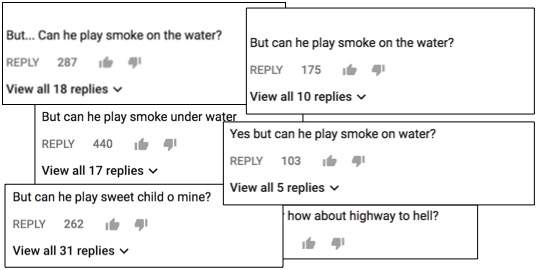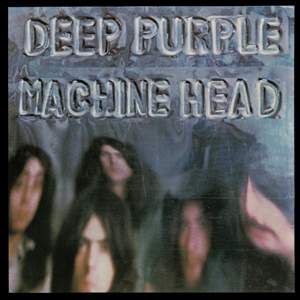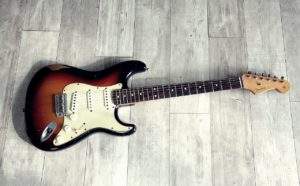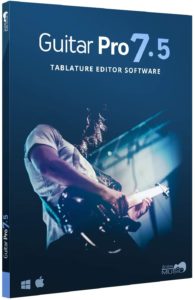Several years ago I started seeing this comment appear regularly under guitar videos on Youtube:
"Nice, but can you play Smoke On The Water?"

In case you haven’t seen the comment before, let me try to explain.
It’s posted after someone has played something, usually something technical, and it’s an in-joke. It’s saying this:
“Smoke On The Water is so easy that anyone could play it, so of course this guy could do it with his eyes shut, teeheehee!”.
These comments get hundreds of likes, and many others join in with variations on the joke.
Amongst the laughter and banter, there’s the sense that a huge number of players think a song like Smoke On The Water is so easy it’s beneath them.
There’s no problem with joking around, but I have some views on this casual disrespect for Smoke On The Water (and other so-called ‘easy’ songs) which I’d like to share with you.
Ok.
I’ve taught rock guitar professionally for over a decade and worked with several hundred students. Some of my students started as complete beginners, but most people who come to me for help have already played for ten or twenty years (or longer). And you know what?
Before joining my lessons, hardly anyone can actually play Smoke On The Water.
Perhaps you think I’m joking myself here, or at least exaggerating? No, I’m being completely serious.
The problem I think is that there is a very large gap between what being able to play a song actually means, and what many guitarists seem to think it means.
Knowing the “main riff” isn’t knowing “the song”
It’s a mindset I see again and again with electric guitar players — they go around thinking they ‘know’ things that in reality they can only do tiny little bits of in isolation, and which they can’t use.
Players think they know a scale when it takes them 5 minutes to get one position together, and then when they stumble through it it’s riddled with errors.
Players think they know how to bend because they can push a string, but not even one out of ten of their bends are remotely near being in tune.
Similarly, guitar players think they know a song because they learned the main riff or the famous hook part back when they started guitar.
And that, my friends, is what I believe has been going on — big time — with Smoke On The Water.
Bro - do YOU even know what to do after the first riff?!
So you know Smoke On The Water? Great – let’s put the track on and play it.
Alrighty then, about 52 seconds in the singer is going to start the verse. What does the guitar do here?
See, I know for a fact that most players in this situation simply stop playing and start looking around awkwardly. Because most players have absolutely no idea what comes after the main riff in most of the songs they know.
Oh well, we’ll just wait for that main riff to come back along. It won’t be long.
What’s that? Damn! The main riff hasn’t come back yet. Instead there seems to be another riff at the end of the verse. That riff repeats twice before the main riff eventually comes back after that.
So far so good — we’ve stood here like a tool for almost a whole minute while the song continues without us.
So the main riff returns around 1 minute 40 seconds — that’s great, because you know what to play again (… for about the next 15 seconds).
This whole pattern will repeat another time, so your next opportunity to play the main riff is at about 2 minutes 40 seconds.
Next up is the guitar solo section. Phew, it’s quite a long one — about 50 seconds.
I’ll be generous now and say you don’t need to play Ritchie Blackmore’s guitar solo. I’ll play that, if you just accompany me on rhythm guitar. Easy.
Bro… don’t tell me you don’t know what to play here either?
“Uh, well, wouldn’t it just be one of the riffs we’ve already had?”
You mean one of the three previous riffs, two of which you probably don’t know? No, sorry bro. There’s a separate chord pattern and ending to go under the guitar solo.
While we’re here, how about that guitar solo?
We skipped right over this a second ago, but we really shouldn’t have. Here’s what’s required:
Scale knowledge
You’ll want to know the Minor Pentatonic and Minor Scales basically all over the neck. You’ll want to be confident picking them straight and in various sequences, and changing between scales with 2 notes on each string (like the pentatonic) and those with 3 notes on each string (like the minor scale and parts of the blues scale).
Technique - Bending
Next, make sure you’ve mastered string bending, because string bends are everywhere in this solo, both on their own (single bends), bends involving more than one note at a time, repeated bends, and super quick ones hidden within fast phrases.
Technique - Finger Rolling
I like to call rolling the least sexy, but most important guitar technique.
To execute several of the phrases as Ritchie Blackmore played them, you need to have a well developed finger rolling technique with your first three fingers to allow you to seamlessly change string to a new note at the same fret.
(I was recently talking to another guy who’s ‘played for over ten years’, who also thought he was beyond this song. It turned out not only could he not roll at all, he had literally never even heard of the technique…)
Technique – Speed with Scales and Sequences
At the fastest points, you’ll also find minor pentatonic and minor scale runs and sequences combining picking and hammer-ons/pull-offs that move at just under 8 notes per second. Yes, 8 notes per second.
How fast is that? If you know the first minor pentatonic scale position, try getting from the first note on the E string to the first note of the B string (that’s across 4 strings, playing all the notes in between) in a second. That’s the kind of average speed you need to move at fluently to be able to play the fastest parts of the original Blackmore solo.
There are countless moments where you’ll get really bad solo ruining string noise if you can’t mute it effectively, and, needless to say, it’s a rock solo, so good vibrato is required throughout.
So we could say there’s a few things to think about to truly accomplish a solo like this. And did I mention:
We’ve still not actually PLAYED the song once yet?
Everything so far is just getting a song to a rehearsal stage.
That means knowing your basic parts before you would actually practice them with a group, or practice playing them through to performance standard.
What is ‘performance standard’? It doesn’t mean you need to actually be performing to a big audience, as in playing in a gig or concert. However, it does mean being able to:
1) Play it all the whole way through, without mistakes
2) While standing up (when did you last see a rock band sitting down?)
3) While turned up loud on a real amp (not a preset on a bedroom amp which disguises your sound)
4) In time and grooving with other instruments (or backing track)
Only when I reliably reach this point with a song will I think of saying to myself “Yeah, I know that song”. And even when I do know it, I know I could still play it better so I don’t stop practicing it.
I would often go a step further and try to come up with some ideas of my own with the track, or even try for example improvising a completely different guitar solo.
This ^ is what it means in real life to be able to play a song, kids.
So tell me, bro… can you play Smoke On The Water?
– Christy






